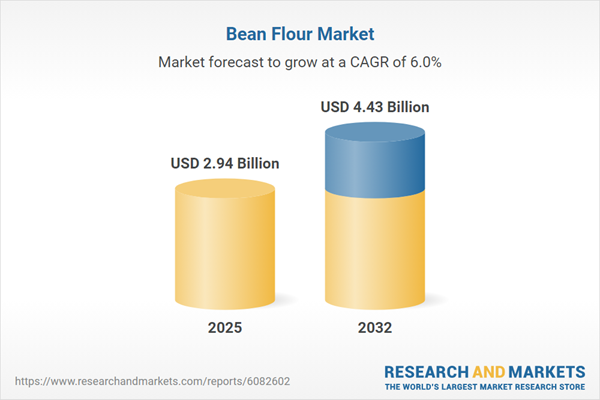Speak directly to the analyst to clarify any post sales queries you may have.
Bean flour is increasingly central to the transformation of global food ingredients, as innovation and sustainability drive change throughout the value chain. Senior decision-makers seeking to capture new opportunities in changing markets benefit from adapting strategies that reflect fast-evolving consumer preferences and regulatory frameworks.
Market Snapshot: Bean Flour Market Growth Outlook
The bean flour market is advancing with steady momentum, moving from USD 2.78 billion in 2024 to USD 2.94 billion in 2025. Projections indicate that the sector will maintain a compound annual growth rate (CAGR) of 5.98%, reaching USD 4.43 billion by 2032. Growth is fueled by robust demand for plant-based proteins, expanded applications in food manufacturing, and supportive policies promoting sustainable nutrition across international supply chains.
Scope & Segmentation of the Bean Flour Market
- Product Types: Chickpea flour, faba bean flour, mung bean flour, pea flour, and soybean flour enable manufacturers to extend B2B use cases and offer tailored ingredient solutions.
- Applications: Opportunities span across bakery goods such as breads, cakes, and cookies; beverages; soups; dietary supplements; plant-based meats; and snacks or savory items including chips and crackers.
- Distribution Channels: Businesses leverage convenience stores, direct-to-consumer online sales, e-commerce platforms, subscription channels, specialty retail, supermarkets, and hypermarkets for multi-channel reach.
- Sources: Conventional and certified organic bean flours support diverse sourcing strategies, aligning with varying procurement standards and consumer certification expectations.
- Processing Methods: Defatted and full-fat processing options enable manufacturers to address a wide variety of nutritional, dietary, and functional requirements for product differentiation.
- Geographic Coverage: The market landscape encompasses North and Latin American countries, major European markets, the Middle East and Africa, as well as Asia-Pacific regions including China, India, Japan, Australia, and Southeast Asia, reflecting strong cross-border and regional demand dynamics.
- Technology and Innovation: Adoptions of high-throughput milling, micronization, air classification, enzymatic processing, product fortification, and digital go-to-market strategies improve efficiency, customization capabilities, and traceability throughout the supply chain.
- Leading Companies Profiled: The report examines the roles of industry leaders such as Archer Daniels Midland Company, Cargill, Ingredion, Olam, Tate & Lyle, Roquette Frères, Puratos, AGT Food and Ingredients, SunOpta, and Axiom Foods, highlighting innovation and supply leadership.
Key Takeaways for Senior Decision-Makers
- Consumer interest in gluten-free and protein-enriched diets continues to diversify product portfolios and stimulate growth across categories.
- Advancements in processing and functionalization technologies allow manufacturers to deliver bean flour with optimized texture, longer shelf-life, and improved alignment with clean-label standards.
- Expansion of direct-to-consumer and online channels provides access to more granular consumer insights, enhancing agility and efficiency in product development and supply chain management.
- Environmental sustainability is increasingly integrated into operations, as nitrogen-fixing pulses underpin reduced agricultural impact and facilitate ESG-driven business strategies for procurement and production.
- Collaboration between suppliers, producers, and research bodies accelerates technological progress, enabling more rapid introduction of market-ready solutions and enhanced industry capabilities.
Tariff Impact: Navigating New Regulatory Realities
The introduction of United States tariffs on imported pulses in 2025 is altering the supply chain landscape, prompting a strategic focus on domestic sourcing and regional consolidation. Companies are adopting more flexible procurement practices, diversifying supplier portfolios, optimizing formulations to manage raw material cost fluctuations, and engaging with policy stakeholders to support ongoing competitiveness in global trade.
Methodology & Data Sources
This report draws on both primary and secondary research methodologies. Data was gathered from structured interviews with industry professionals, supplemented by market reports, academic literature, and government documentation. Expert panel reviews were conducted to verify credibility and ensure triangulation of findings.
Why This Report Matters
- Receive actionable market intelligence supporting strategic planning, procurement, and risk mitigation as the bean flour market evolves.
- Gain visibility into key regional trends and application-driven opportunities to inform investment and expansion decisions amid complex supplier networks.
- Benchmark against leading brands and emerging technologies to sharpen your organization’s competitive strategy and innovation outlook.
Conclusion
The bean flour market is defined by evolving consumer requirements, regulatory changes, and innovative supply chain models. This report provides senior leaders with the analysis required to align business objectives, navigate complex regulations, and leverage opportunities for future growth.
Table of Contents
3. Executive Summary
4. Market Overview
7. Cumulative Impact of Artificial Intelligence 2025
Companies Mentioned
The companies profiled in this Bean Flour market report include:- Archer Daniels Midland Company
- Cargill, Incorporated
- Ingredion Incorporated
- Olam International Limited
- Tate & Lyle PLC
- Roquette Frères
- Puratos Group SA
- AGT Food and Ingredients Inc.
- SunOpta Inc.
- Axiom Foods, Inc.
Table Information
| Report Attribute | Details |
|---|---|
| No. of Pages | 193 |
| Published | November 2025 |
| Forecast Period | 2025 - 2032 |
| Estimated Market Value ( USD | $ 2.94 Billion |
| Forecasted Market Value ( USD | $ 4.43 Billion |
| Compound Annual Growth Rate | 5.9% |
| Regions Covered | Global |
| No. of Companies Mentioned | 11 |









